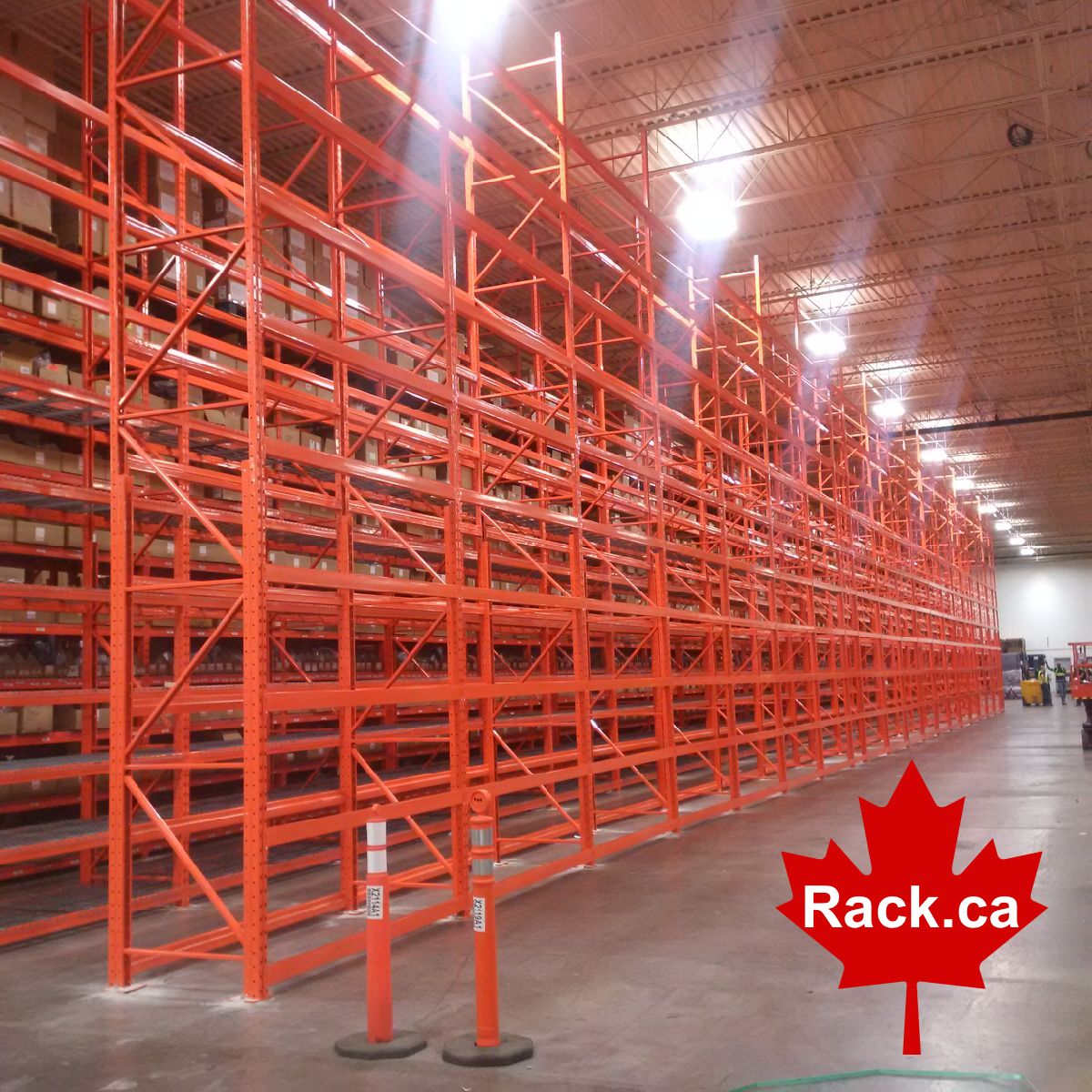Warehouse inventory or pallets that are stored high up on storage units can sometimes fall over for a number of reasons including improper stacking, human error, misjudging the space between pallets, damaged hardware, etc. This is never a good thing. Falling items can increase the risk of merchandise damages, onsite employee injuries, and general liability for your company.
To reduce the risk of falling items in your warehouse or storage facility, it’s important to increase, update, and pay special attention to pallet rack safety standards at all times.

Pallet Rack Storage Unit Design and Installation
Pallet rack and warehouse safety starts with purchasing the right racking systems that suit the layout of your facility. High design and installation standards are key aspects of any pallet rack storage system design and installation application. Chances are that your warehouse stores and ships a wide variety of inventory. Some pallets may bare much heavier loads than others—it all depends on the merchandise inside the boxes.
For this reason, proper weight distribution on each beam makes a big difference. Before purchasing a pallet racking system for your warehouse or shipping facility, you need to take the type of inventory you have into account. Choose a pallet rack storage system that’s designed specifically to handle heavy loads and place pallets strategically in an organized fashion to reduce the risk of falling items.
Make sure that all pallet racks are properly installed and secured in place to prevent toppling over. It’s also your responsibility to provide thorough training and certificate courses to all of your employees, particularly those who will be operating heavy machinery such as forklifts in your warehouse. Warehouse equipment training should be administered routinely on a recurring basis even for seasoned professionals to ensure that all of their skills are completely up-to-date and in compliance with Ontario’s safety standards.
Pallet Loading
All shipping and receiving employees should be adequately trained and prepared to work in your warehouse or facility. Part of that training involves teaching them how to properly load and unload pallets in a way that adheres to legal and company safety standards. Employees should know which type of machinery to use for specific purposes and they should always be accompanied by a backup when moving particularly difficult loads.
The following tips to prevent items from falling can help you reduce the risk of damages and injury in your warehouse.
Leave Adequate Space between Pallets
Proper pallet spacing is an incredibly important component of storing inventory. It’s important to make sure that there’s an appropriate amount of space between each pallet to avoid rubbing up against each other during the loading, unloading, or moving processes.
Leaving an adequate amount of space between pallets increases organization and it also allows machine operators to account for the size and weight of their material handling equipment. They can easily maneuver products around without worrying about knocking things over by accident.
Stack Pallets Based on Weight
Warehouse operating standards dictate that each pallet with merchandise on it should be aptly weighed and documented before being placed on a pallet rack storage system. Heavy load bearing pallets should be placed at the very bottom of the unit whereas lighter load bearing pallets should be placed higher up.
This will increase the unit’s structural stability and lower the risk of injury or damage if an item does fall off. Since heavier items are placed closer to the ground, the impact in the event that they should fall over will be much lighter than if they were to fall from the top of the unit.
Pay Attention to Load Distribution
Load distribution on each pallet and the levels on which they’re stacked is also a cause for concern in a lot of cases. Oftentimes, individual pallets contain a variety of different types of merchandise, some of which are heavier than others. Heavier items should be placed in the middle of the pallet with lighter less fragile items surrounding them. This makes it easier to move pallets with material handling equipment.
By the same token, heavier pallets should be placed toward the bottom of the pallet rack storage units to reduce the risk of damage and injury during loading, unloading, and other applications.
Take Good Care of Pallet Rack Storage Systems
This goes without saying, but you should take very good care of your pallet rack storage systems. The more you look after your storage units and keep them organized as much as possible, the longer they’ll last without needing repairs or replacements. In the long run, routine maintenance will save you a great deal of money. After all, pallet rack storage systems are a necessary business investment.
The following is a list of standard pallet rack safety tips that all warehouse, material handling, and shipping and receiving workers should follow at all times.
Perform Regular Pallet Rack Safety Inspections
Performing regular pallet rack safety inspections will help you spot potential problem areas right away. Look for missing or damaged hardware, unstable shelving, missing beam clips, and any other signs of disrepair.
Report All Onsite Incidents
Up-to-date incident reports are a great way to document potential health and safety issues and patterns occurring in your warehouse or facility. These reports also keep you liable for the health and safety of all of your employees while giving them peace of mind knowing that they have some form of recourse and support in the event that an incident does occur.
Double Check Pallet Storage System Size and Capabilitie
Before purchasing a pallet storage system for your warehouse or industrial facility, it’s important to consider the size and load bearing capabilities of the unit. Take into account the type and weight of the inventory that comes in and out of your warehouse on a regular basis and make sure that the pallet storage system is capable of holding that kind of weight at all times.
Canadian Rack Technologies Inc. offers a wide range of safe and easy-to-use pallet rack storage systems that are perfect for all warehouse, shipping and receiving, and industrial applications. We’ll map out a series of customizable pallet rack safety plans that are specially designed for your warehouse or facility. Contact us today to learn more.
